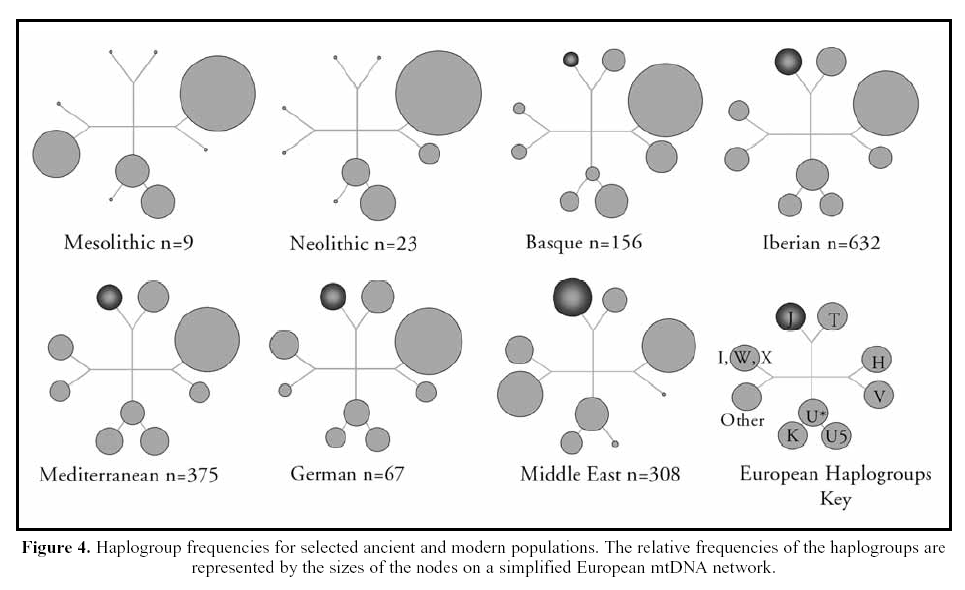Via Mathilda's Anthropology Blog, one of my favorites because even if she often dwells in non-recent papers, these are almost always very interesting for those who, like myself, are fascinated by human prehistory. Also is probably the only anthropology blog that dedicates a lot of articles to North Africa.
The paper is: Using ancient DNA to examine genetic continuity at the Mesolithic-Neolithic transition in Portugal (H. Chandler, B. Sykes and J. Zilhao, 2005). More than two years old but still a novelty for me.
There's an interesting introduction on Zilhao's view of the Epipaleo-Neolithic transition in central and southern Portugal and then the interesting stuff comes all in figure 4:
 What do you see? I see continuity. Sure: some unexpected N* has vanished and some V has appeared. But this variance is normal between any two different samples and the rest remains all the same: H dominance and some U (U5 and U* that is surely all U6)
What do you see? I see continuity. Sure: some unexpected N* has vanished and some V has appeared. But this variance is normal between any two different samples and the rest remains all the same: H dominance and some U (U5 and U* that is surely all U6)Chandler et al. instead read discontinuity: immigration from some nearby West Mediterranean (European) source and population replacement. Well in the line of Zilhao's vision of Portuguese Neolithic transition.
Whatever the case, it is noticeable that none of the so-called Neolithic clades (especially but not only J) were present then. J, T, K, X and W must have arrived to Portugal (and presumably to all SW Europe) later on, at least in the Chalcolithic, maybe even later. These clades are also the smallest ones (together with U6) among Basques (of all modern samples). This would seem to ratify the generally accepted belief that Basque people are among the least influenced by post-Neolithic genetic influx in Western Europe and that H, V, U5, U6 (along with some mysterious N*, maybe R*, and U8a in the Basque case) constituted the Paleolithic mtDNA pool of SW Europe.
Haplogroup U* (U6):
It is noticeable that U* (U6) was already important in southern Iberia in pre-Neolithic times, what may contradict Maca-Mayer's rather forced interpretation of the U6 variability and spread. She argues for Iberian U6 to be not older than 10,000 years ago but she fails to provide an archaeological mechanism for that migration (while disregarding as merely accidental the fact that the highest variability of U6 is in Iberia and Western Berbers, and not in her alleged urheimat of the Nile). All that reasoning is founded in two factors:
1. That U6 is almost not found in Europe outside Iberia (though in fact it is occasionally found in France and Italy, with an unnamed distinct subclade unique to Sardinia)
2. That Oranian (Iberomaurusian culture) expanded from East to West (against the C-14 actual datations).
I suspect (and this suspicion grows stronger the more I read on the matter) that Oranian does actually honor its original name of Iberomaurusian and is derived from the Gravetto-Solutrean of southern Iberia, expanding from West to East in North Africa, bringing with it European haplogroups like U6, H and V (and maybe also Y-DNA R1b, rather common in Sudan and Upper Egypt) as well as technlogical and artitistic manifestations. U6 would then be the product of an early UP founder effect in southern Iberia, much like U8a among Basques. The counter-tide would belong to Capsian culture, which would have brought Y-DNA E1b1b (maybe together withmtDNA L, too common in North Africa to be just product of the rather minor trans-Saharan slave trade) as well as Afroasiatic languages.
.










No comments:
Post a Comment